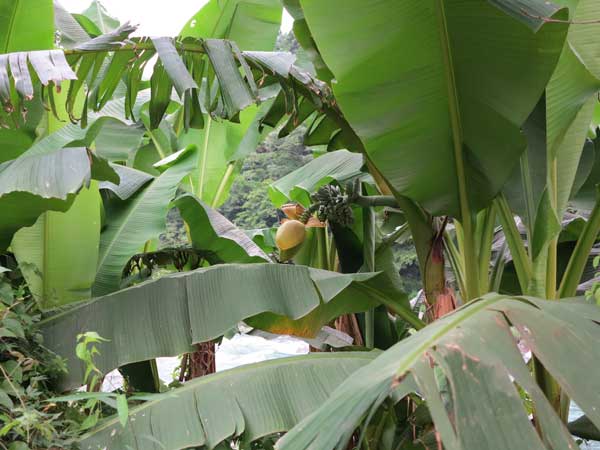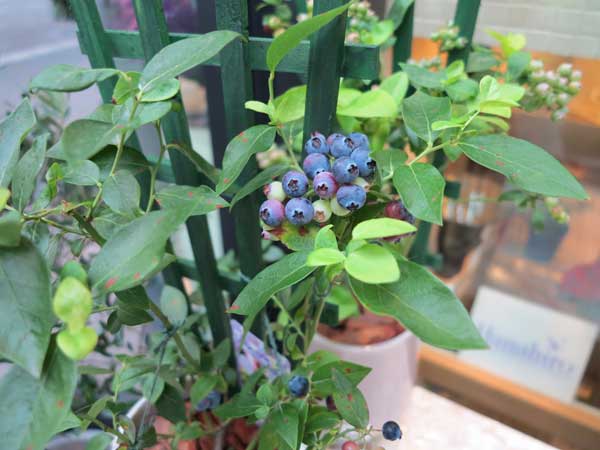
実
Gorgeous cucumber flowers, but unfortunately no cukes
Balloon vine is a fun summer climber

経堂駅から農大に行く途中で、面白い庭がある家をいつも観察します。去年は色々なアサガオが育っていました。今は、背の高いフウセンカズラがたくさんの緑とオレンジ色の実を見せてくれています。私たちのベランダにもこの夏のつる草があります。
On the long walk from Kyodo station to Nodai (Tokyo University of Agriculture), there’s a house and large garden where the residents are always gardening. This year they created a huge, two meter high trellis of fusenkazura (フウセンカズラ). The name is literally balloon kudzu, and despite looking delicate, it’s very hardy. The vine produces lots of white flowers, followed by a multitude of green balls that then turn orange. This year, I’m growing two specimens on our balcony.
Summer makes me want to jump in cold river

蒸し暑い天気のときに一番涼しいところは、冷たい川の中です。@a_small_lab と @jessmantell と御嶽に行きました。東京にあんな自然がまだあります。実がついたバナナを見て、驚きました。
In summer’s heat and humidity, the best place to be is in a cold river. Recently I met up with @a_small_lab and @jessmantell at the Tama river up in the foothills of western Tokyo. At Mitake, you can feel that you are in the mountains while being still in the city. It’s about an hour and a half by train from central Tokyo, and the water is cold!
I was very surprised to see bananas growing by the river. The fruit is now forming.


Blueberry bush with fruit for sale at Marunouchi flower shop

This gorgeous blueberry plant, full of perfect fruits, is being sold at Marunouchi flower shop. I love how it’s getting more common to use edibles as decorative landscape.
Yamamomo tree near Tokyo Metropolitan Government building

Commonly called Japanese bayberry, this fruit tree near Tokyo Metropolitan Government was full of yamamomo fruits. This tree is apparently often planted along roads and in parks. I love how the fruit is at once edible and very ornamental.
Still dormant persimmon bonsai on Tokyo balcony. Enjoying plants involves waiting.

My balcony garden is starting to perk up for spring, but this persimmon bonsai is still dormant. I remember the day I brought it back two years ago. My neighbor asked me what I have, and then gave me a sad look. “You know it takes eight years for persimmons to fruit, don’t you?” she asked me. I am more patient than I look.
Tokyo strawberries, with promise of fruit in all four seasons

Recently I picked up strawberries from the home center, full of pretty white flowers. They were less than $2 each. I think it’s very interesting that they’re called “Tokyo strawberries.” In this urban country, it makes sense to develop and target plants, even vegetables, to city growers.
The label also boasts, “Pure Berry 2” with a registered trademark. But the biggest promise is strawberries in all four seasons. I am looking forward to my first balcony strawberry!
Giant electric pole dwarfs persimmon & street
 東京の中には、たくさんのあまりきれいでないものがあります。とても高い電線は江戸時代の五日市街道の上を渡ります。ごみ焼却炉の煙突や高架道路やマンションの終わらない蛍光灯の列も都市生活に奇妙なリズムをつくります。このとても高い電線の下に柿の実が見えます。
東京の中には、たくさんのあまりきれいでないものがあります。とても高い電線は江戸時代の五日市街道の上を渡ります。ごみ焼却炉の煙突や高架道路やマンションの終わらない蛍光灯の列も都市生活に奇妙なリズムをつくります。このとても高い電線の下に柿の実が見えます。
There are many urban sights in Tokyo that are jarring to newcomers, perhaps none more so than the giant electricity poles. Well, there’s also garbage incinerators with tall chimneys in every neighborhood, elevated freeways, endless rows of fluorescent lights stacked high on exposed residential hallways, and the zeal for paving over almost all surfaces.
This photo was taken near Shin Koenji where the elevated main power line crosses Itsukaichi Kaido, a road that dates back to Edo and maybe earlier. You can just make out a silhouetted ripe persimmon fruit. Sometimes these unattractive elements create their own rhythm and patterns in urban life.
Summer is loquat season in Tokyo

東京のどこにも、びわの木があります。実の色が大好きです。だれでも食べられます。だけど、お隣が道でなっているびわを食べているところを見たことがありません。
Everywhere I walk in Tokyo, I see loquat trees (called biwa in Japanese 枇杷) on the sidewalks: planted between the sidewalk and roadway, next to a Royal Host, coming out of a shrine. Loquat seems well adapted to Tokyo, and it’s great to see such huge trees full of orange fruit and accessible from the street. I have to keep my eye out to see if the neighbors eat them.





